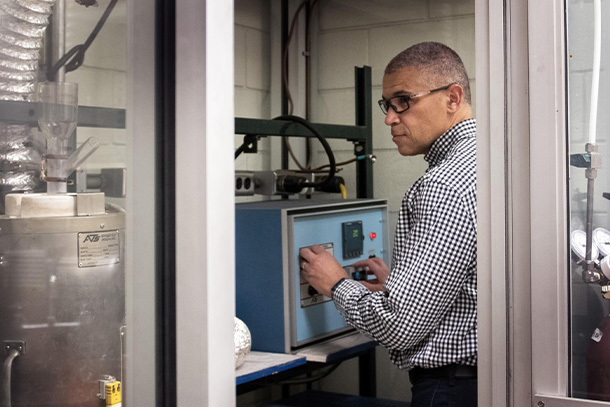
David Mazyck, head of Penn State's School of Engineering Design and Innovation, returned to Penn State after two decades away. The decision, he said, brought him back into a community that had helped foster his interest in engineering. Credit: Patrick Mansell / Penn State. Creative Commons
Engineering alumnus building opportunities for student leadership, research
'Boomerang' Penn Stater David Mazyck works alongside his mentors to build foundational student experiences through the School of Engineering Design and Innovation, or SEDI
May 9, 2024
Editor’s note: A version of this article was first published on Penn State News.
UNIVERSITY PARK, Pa. — For alumnus David Mazyck, returning to Penn State as the department head of the School of Engineering Design and Innovation (SEDI) within the College of Engineering was an appealing proposition. He’d been working for the University of Florida for 22 years, and while he enjoyed his time there, Penn State offered something he was interested in: familiar faces and a chance to give back to the community he’d learned from.
“To me, an administrator’s career is about helping others, versus trying to build their own career,” Mazyck said. “That's something I'm very passionate about, is helping staff, faculty and students make that next step, that next part of their journey.”
Mazyck earned three degrees from Penn State: a bachelor’s degree in civil and environmental engineering after starting at the Wilkes-Barre campus, and master’s and doctoral degrees in the same field. The support and undergraduate research experiences he’d received from the College of Engineering as a student, he said, had driven his interest in the field of engineering.
“Undergraduate research helped connect science and engineering to a practical application, helping to understand why all of the foundational courses mattered,” Mazyck said. “It provided that motivation to push on versus starting to dwell on ‘the why.’”

David W. Mazyck at the controls of the activation furnace. Credit: Patrick Mansell/Penn State. Creative Commons
His role as head of SEDI lets him continue that effort for current students, often alongside the very people who taught him. When he returned to Penn State in 2022, he recognized members from his doctoral committee still at work in the College of Engineering.
His mentor from his student days, Fred Cannon, had only recently retired, and Ljubisa Radovic shortly thereafter. Others, like Civil and Environmental Engineering Professor Bill Burgos, were still faculty and assisted with Mazyck’s transition.
Beyond the familiar faces, he said, he can see his own impact on the University — without searching very far.
“I had to build a piece of equipment for my research. When I came back, I was curious to see if it was still here,” Mazyck said. “And it is. So yeah, I did a pretty good job. Now my current students can understand carbon science in the same lab with the same equipment.”
It’s that kind of long-lasting work that Mazyck aims to provide for students.
“The difference between successful students in their careers and those who struggle could be tied back to a five-minute time of their life,” Mazyck said. “It could be five minutes they were able to spend with a faculty member who gave them some wisdom or shared with them an opportunity or brought them into their lab.”
Part of the appeal of his current position, Mazyck said, is the setup of SEDI itself. The school is unique in that it doesn’t offer a bachelor’s degree specific to its program. Instead, it offers classes like EDSGN 100, which roughly 85% of engineering students take, and a variety of study abroad experiences.
In addition, SEDI offers minors and certificates including engineering design; engineering leadership; engineering entrepreneurship; law, policy, and engineering; and humanitarian engineering and social entrepreneurship.
“If you ask employers, ‘What's the number one skill that most engineers are missing upon graduation?’, they would say leadership,” Mazyck said. “SEDI offers experiences to allow engineers to learn those skills and begin to tailor their careers as they make the transition from Happy Valley to their next journey.”
The position also oversees the two- and four-year engineering programs at many of the Commonwealth Campuses. Given his own history at a Commonwealth Campus, he said, this was an aspect of the position that mattered a lot to Mazyck.

Graduate student Domenic Contrino pours activated carbon into the furnace. Credit: Patrick Mansell/Penn State. Creative Commons
Also of interest, he said, are the connections that SEDI forms between different disciplines and units. Because its courses are supplemental, it can bring together students from across a wide range of fields.
“SEDI is a connector not only across the college, but across the entire University. We’ve got students in entrepreneurship from several colleges,” Mazyck said. “The opportunity to be a connector across these potential silos on a campus is really fascinating.”
Beyond any of that, though, is the University culture. Penn State feels like a community, Mazyck said, full of people he knows and who work together to achieve their end goal: providing opportunity for students. And the students, he said, are just as enthusiastic.
“When you're at Penn State, you know you're at Penn State. One of my entire office walls here is glass, and I can see students crossing over Westgate wearing Penn State shirts,” he said. “There is a big community on campus as well as in the surrounding State College area. You feel like you're a part of a big family.”



